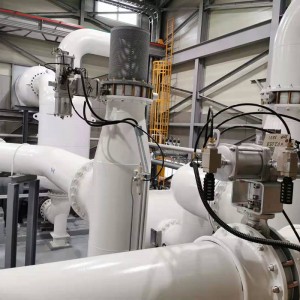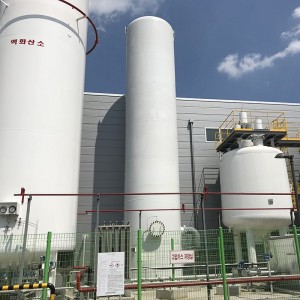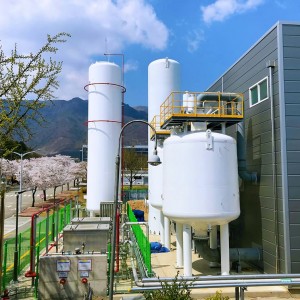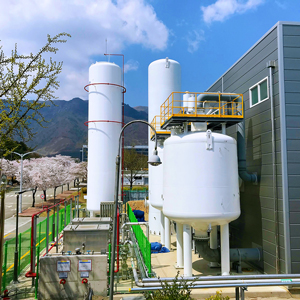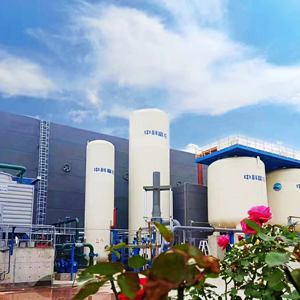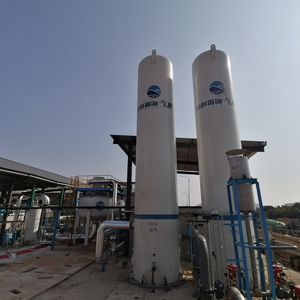- Typical feed: Air
- Capacity range: 5~200Nm3/h
- O2 purity: 90%~95% by vol.
- O2 supply pressure: 0.1~0.4MPa(Adjustable)
- Operation: automatic, PLC controlled
- Utilities: For the production of 100 Nm³/h O2, the following Utilities are required:
- Air consumption: 21.7m3/min
- Power of air compressor: 132kw
- Power of oxygen generator purification system: 4.5kw
Vacuum Pressure Swing Adsorption (VPSA) Oxygen Production Technology is used in various industries such as Iron and steel, nonferrous metals, glass, cement, pulp and paper and so on. This technology is based on the different adsorption capabilities of the special adsorbent to O2 and other compositions in the air.
According to the required oxygen scale, we can flexibly choose axial adsorption and radial adsorption, the process is consistent.
Technical Features
1. The production process is physical and does not consume adsorbent, long service life of major oxygen generation adsorbent is guaranteed by efficient composite adsorbent bed technology.
2. Quick startup; after planned shutdown or troubleshooting of non-planned shutdown failure, the time needed to restart till the production of qualified oxygen will not exceed 20 minutes.
3. Competitive energy consumption.
Low pollution, and almost no industrial waste is discharged.
4. Modular design, high integration level, fast and convenient installation and overhaul, small quantities of civil works, and short construction period.
(1) VPSA O2 Plant Adsorption Process
After being boosted by roots blower, feed air will be directly sent to the adsorber in which various components (e.g. H2O, CO2 and N2) will be successively absorbed by several adsorbents to further obtain O2 (the purity may be adjusted through the computer between 70% and 93%). O2 will be output from the top of the adsorber, and then delivered into the product buffer tank.
According to customer requirements, different types of oxygen compressors can be used to pressurize the low-pressure product oxygen to the target pressure.
When the leading edge (termed as adsorption leading edge) of the mass transfer zone of absorbed impurities reaches a certain position at the reserved section of the bed outlet, the feed air inlet valve and the product gas outlet valve of this adsorber shall be shut off to cease absorption. The adsorbent bed begins to shift to the equal-pressure recovery and regeneration process.
(2)VPSA O2 Plant Equal-Depressurize Process
This is the process in which, after the completion of the adsorption process, relatively high pressure oxygen enriched gases in the absorber are put into another vacuum pressure adsorber with the regeneration finished in the same direction of adsorption This is not only a pressure reduction process but also a process of oxygen recovery from the dead space of the bed. Therefore, oxygen can be fully recovered, so as to improve the oxygen recovery rate.
(3) VPSA O2 Plant Vacuumizing Process
After the completion of pressure equalization, for radical regeneration of the adsorbent, the adsorption bed may be vacuumized with a vacuum pump in the same direction of adsorption, so as to further reduce the partial pressure of impurities, fully desorb adsorbed impurities, and radically regenerate the adsorbent.
(4) VPSA O2 Plant Equal- Repressurize Process
After the completion of the vacuumizing and regeneration process, the adsorber shall be boosted with relatively high pressure oxygen enriched gases from other adsorbers. This process is corresponding to the pressure equalization and reduction process, which is not only a boosting process but also a process of oxygen recovery from the dead space of other adsorbers.
(5) VPSA O2 Plant Final Product Gas Repressurizing Process
After Equal- depressurize process, to make sure the stable transition of the adsorber to the next absorption cycle, guarantee the product purity, and reduce the fluctuation range in this process, it is necessary to boost the pressure of the adsorber to the absorption pressure with product oxygen.
After above process, the whole cycle of “absorption – regeneration” is completed in the adsorber, which is ready for the next absorption cycle.
The two adsorbers will work alternatively according to specific procedures, so as to realize continuous air separation and obtain product oxygen.



